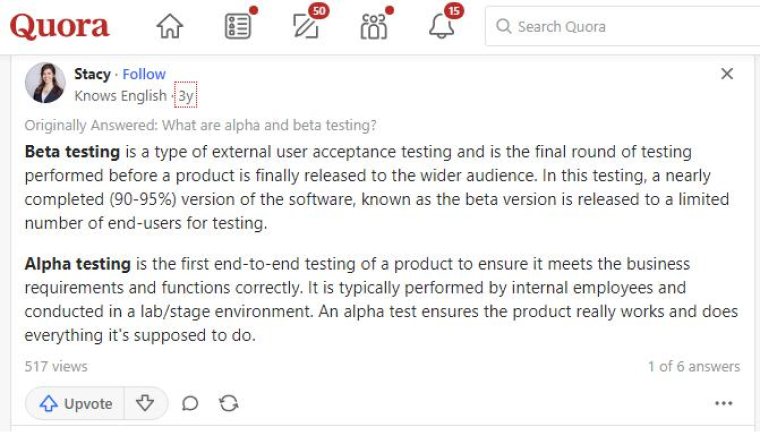
Today, we have a variety of software, each serving its purpose. The number of available software options has increased with the arrival of mobile devices. Just think of anything, for example, newly launched financial schemes. Search for related mobile or web applications in the Play Store, and you’ll find at least one that meets your needs. In such a scenario, it’s necessary for a software testing company to take care of the software quality before it reaches the customer’s hands. Hence, IT companies conduct software testing after development.
With an increase in the types and numbers of applications, the types and numbers of software testing have also increased. One can get confused about which test to execute and when. Alpha and beta testing occur in the final testing stage of the product, as it involves testing by actual users.
In this blog post, we’ll compare alpha testing vs beta testing in terms of features, types, advantages, disadvantages, similarities, and differences.
1. What is Alpha Testing?
Alpha testing is a form of user acceptance testing conducted to identify errors, bugs, or usability issues and address them before the software is released to the market. It involves black box testing and white box testing techniques. Alpha testing is an internal quality assurance process carried out by the internal employees of the development team in a controlled environment.
1.1 Features of Alpha Testing
- Limited Testers: Alpha testing is conducted by internal testers such as developers and QA engineers.
- Testing Environment: It is conducted in a simulated setting that closely resembles the actual environment.
- Multiple Iterations: It involves numerous testing rounds, which can lead to lengthy test cycles.
1.2 Types of Alpha Testing
Here are 5 types of alpha testing:
- Functionality Testing: Validates the working of the software functions according to the expected behavior.
- Security Testing: Checks for vulnerabilities to prevent unauthorized attacks.
- Performance Testing: Checks the application’s behavior under different conditions.
- Usability Testing: Assesses the software’s user experience to make the product user-friendly.
- Regression Testing: Performed after bug fixing to verify the software’s existing functionalities are working.
1.3 Advantages of Alpha Testing
- Improved Product Quality: The rigorous testing of the product refines it, thus enhancing its stability and reliability before it reaches external users.
- Cost Effective: Early detection and fixing of bugs saves the cost associated with the later testing phases.
- Early Feedback: Alpha testers give direct and detailed feedback to enhance the product quality by immediately working on the input.
1.4 Disadvantages of Alpha Testing
- Biased Testing: Alpha testers are developers and QA professionals, so they can miss out on the non-technical aspects that an end user might notice.
- Virtual Environment: The virtual environment used for alpha testing ignores real-world scenarios like battery performance and memory consumption.
- Budget Restrictions: Alpha testing involves significant resources like virtual machines, simulators, bug-tracking tools, etc., which can be expensive.
2. What is Beta Testing?
Beta testing occurs in the last phase of the product development lifecycle, just before the product release. During this phase, a group of real users tests the pre-released version of the product in a real environment. It is performed after alpha testing has been completed.
2.1 Features of Beta Testing
- Real-time Environment: One can know the actual performance of the application by testing it in actual user environments.
- User Feedback: Beta testing focuses on gathering feedback about the user experience as end users perceive it.
- Short-Term Release: Typically, beta versions are time-limited and may expire after the beta testing period.
2.2 Types of Beta Testing
There are five primary categories of beta testing.
- Closed Beta Testing: Beta testing is conducted by a small and selected group of actual users.
- Open Beta Testing: A large number of users test to collect quantitative data on user interaction.
- Technical Beta Testing: Beta tests are conducted by internal testers with technical expertise to test technical aspects.
- Focused Beta Testing: Tests particular features or functionality such as a new update instead of the entire application.
- Marketing Beta Testing: Beta testing is conducted to create media awareness about the product before the product launch.
2.3 Advantages of Beta Testing
- Increased Awareness: Beta testing allows customers to directly interact with the application before its official launch resulting in pre-release product awareness.
- More Platform Coverage: Beta testing is conducted on different platforms like multiple types of devices, operating systems, and browsers.
- Reduces Failure Risk: Beta testing helps validate the product through user feedback, which lowers the risk of failure after product launch.
2.4 Disadvantages of Beta Testing
- Testers Reliability: The success of beta testing depends on the responses and feedback from the testers.
- Time-Consuming Process: Finalizing the potential testers, providing them with resources, and collecting their feedback takes a significant amount of time.
- Restricted Test Coverage: Some issues may remain unseen until the product reaches a wide user base.
3. Key Differences: Alpha Testing vs Beta Testing
- Alpha testing includes both black and white box testing while beta testing primarily utilizes white box testing techniques.
- The internal employees conduct alpha testing, while external users or real customers perform beta testing.
- Alpha testing occurs in a controlled environment, while beta testing is done in the actual environment.
- Alpha testing is primarily concerned with identifying specific bugs and verifying core functionalities, whereas beta testing focuses on broader aspects such as usability, security, compatibility, etc.
- Alpha testing takes substantial time due to the high number of iterations compared to beta testing which addresses only major issues.
Here is what Quora user says about Alpha testing & Beta testing.

4. Key Similarities between Alpha and Beta Testing
- Both alpha and beta testing are classifications of user acceptance testing focusing on user experiences.
- Both the tests are based on user feedback to enhance software quality and meet project and business specifications.
- Both testing processes are iterative. According to the gathered feedback, the product is exposed to multiple testing cycles before product launch.
- Documentation of detected bugs and their fixing is necessary for both alpha and beta testing for future improvements.
5. Tabular Comparison between Alpha and Beta Testing
The following table summarizes the difference between alpha and beta testing.
| Parameters | Alpha Testing | Beta Testing |
|---|---|---|
| Testers | Alpha testers are internal employees involved in the testing and development process. | External users or stakeholders outside the organization |
| Testing Environment | Alpha testing is implemented in a lab or controlled environment | No need for any simulated testing environment |
| Testing Place | The test is performed at the developer’s site | The test is performed at the user’s place |
| Testing time | During the last phase of the product development process before its release | After alpha testing during the product marketing. |
| Testing Technique | Black box testing and white box testing techniques are used to execute alpha tests. | The beta phase uses the black box testing technique. |
| Test Duration | Test cycles depend on identified defects but generally, alpha testing has 1-2 weeks of a single test cycle. | Beta testing takes a few weeks based on user feedback. |
| Test Approach | An alpha test follows a strict and structured approach | Beta testing follows a completely unstructured approach |
| Reliability and Security | These parameters are not deeply evaluated | Detailed testing for robustness, reliability, and security of the application |
| Post Testing | Alpha testing helps to fix critical issues and major bugs immediately | Users provide feedback that is implemented in future versions. |
6. Final Words
The software development process includes various phases of which we saw two aspects of the software testing phase. The alpha testing phase assesses the product quality in the early stages before moving to beta testing. Users actively interact with the beta version and provide feedback that helps meet their expectations. Both alpha and beta testing ensure product performance and stability in the long run. Hence, organizations must recruit skilled professionals in testing teams along with the development team.
The above blog has compared both alpha testing vs beta testing from different perspectives. Go through it carefully and understand.
FAQs
What is an example of alpha testing?
Here’s an example – If Amazon adds any new feature to its mobile application, it will first go for alpha testing. Just after the update, the internal testers test the application and check for potential defects.
What is an example of a beta test?
You might have heard or seen the beta version of any iOS application update on the App Store. This is done so that users can use the application and share their experience regarding any bug or potential improvement.






Comments
Leave a message...